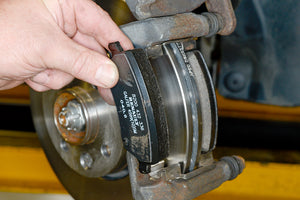They may only be small, but the brake pads provide a vital role! The braking system consists of hydraulically actuated pistons housed within metal (usually cast iron) calipers.
The pistons force the brake pads (which are fitted in pairs) onto the brake discs and use friction to convert kinetic energy into thermal energy – which is why brakes get so hot in use.
The actual pad consists of a steel backing plate and a 'friction material', and as you brake minute amounts of this material are transferred onto the disc, and it is this that gives brakes their 'bite' (and the reason why new pads need to be 'bedded in' correctly).
The actual friction material is what dictates how well the pads perform, and different compounds can affect the service life of the pads and the ability to resist brake fade (when the brakes become less effective the hotter they get).
There is always a trade off between performance and service life, and some pads are designed to recover from extremes of heat that would otherwise damage a 'normal' brake pad.
Discover how to replace the front brake pads on your car!
There are lots of different types of friction material but the main groups are:
- Non-metallic/Organic – a combination of synthetic substances bonded together. Short service life, but reduced brake disc wear. These are the pads most commonly fitted to standard road cars.
- Semi-metallic – Synthetic substances, plus metal compounds. Harder wearing than non-metallic, but harder on brake discs, and can give poor pedal feel until warm/hot.
- Fully-metallic – Generally reserved for race applications. Can withstand huge temperatures, but need to be very hot to work effectively and are very hard wearing on discs.
- Ceramic-metallic – Composed of a dense ceramic material and copper strands. The most expensive of all the pad materials, consistent performance whatever the temperature, extremely quiet operation and brake dust that doesn't stick to your wheels!
Pads are specified to work within an optimum temperature range for their fitment – hence you'll get different pads designed for a 1.0 hatchback, compared to those fitted to a supercar.
Not only is the friction material different, but the sizes can vary, with large or performance cars featuring substantially bigger pads than more humble vehicles.
As the pads wear down they need to be replaced well before the steel backing makes contact with the disc. Some pads require a visual inspection, some incorporate audible wear indicators (that squeal as the brakes wear low), and others contain sensors that trigger a warning light on the dashboard when they get to a prescribed limit





















